Original URL: https://www.theregister.com/2012/12/22/space_review_of_2011/
365 days in SPAAACE: An interstellar glance at 2012
Curiosity looks for Martians, we search for a habitable planet
Posted in Science, 22nd December 2012 11:57 GMT
In a year dominated by Martian news, the pioneering Earthling spirit of one Elon Musk and the hunt for a second human home also grabbed some cosmic headlines.
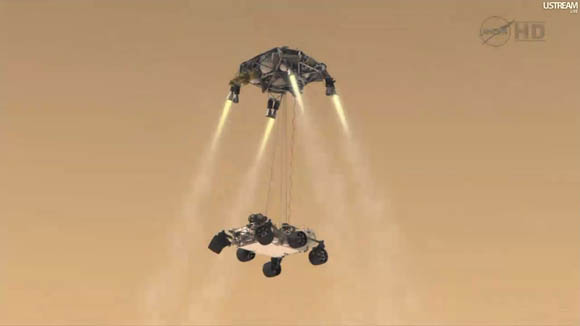
The year started with Curiosity's journey to the Red Planet, dodging solar flares as it thrust its way towards its mission on Mars.
Despite the brand new landing system, NASA was feeling pretty cocky as the nuclear truck neared its destination, electing to drop the rover a lot closer to the potential accident site of Mount Sharp. You would have thought the name alone would be enough to put the astronaut centre off, but NASA moved the landing site nearer and narrowed it by eight miles (13km).
Curiosity descended to the Martian surface in a whole new way for the space agency, lowering under a first-of-a-kind rocket-powered sky-crane. The team had seven minutes to get it from the top of the atmosphere to the ground, going from 13,000 miles an hour (21,000kmph) to zero in that time.
Once the rover and the sky-crane reached nearly zero velocity, the crane just let go of the truck, easing it to the ground on the end of a rope. NASA was relying on the onboard computer to tell it when Curiosity touched the ground, so that the lander could detach and zoom away to a crash landing elsewhere.
"Twenty metres above the surface, we have to lower the rover below us on a tether that's 21 feet long, and then gently deposit it on its wheels on the surface," engineer Adam Steltzner said. "It is the result of reasoned engineering thought, but it still looks crazy."
Luckily, it all went according to plan, with the "one-ton American automobile" kissing the Martian dirt precisely on schedule, leaving NASA boffins and engineers to do that most American of celebrations, hugs all round.
Once safely landed, Curiosity needed an OS upgrade big enough to give its modestly specced motherboard a full workout. The rover then raised its main antenna and gave NASA its first colour pictures of the landing site.
The nuclear Martian space-truck is packing a laser
While some have suggested that the camera equipment and beam-back tech is an unnecessary addition to science missions, Curiosity has stayed alive in the public's imagination with constant new shots of itself and the Red Planet. The rover even got in on the latest viewing craze - 3D. While trundling along on its way to the investigation site at the Gale crater, the space-truck snapped a 3D shot of its surroundings.
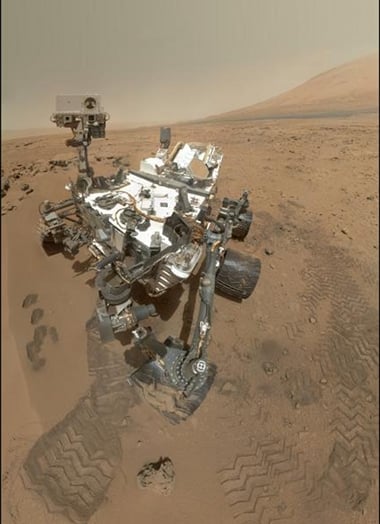
But the rover is also on Mars to fulfill its primary mission - discovering if the planet has ever or could ever support microbial life. To that end, Curiosity started with its first target, the rock N165.
The science lab is equipped with all manner of instruments, including the ChemCam, its chemistry and camera tool, which happens to have its own laser. That laser beam is what explored the Martian rock, blasting it with 30 pulses over a 10-second period, each of which delivered more than a million watts of power for about five one-billionths of a second.
Aside from the general coolness of having such a weapon, Curiosity's laser excites atoms to an ionised, glowing plasma, which can then be analysed with spectrometers to see what elements are inside. And of course, should the rover encounter any hostile aliens, it's always better to be prepared...
With the Martian rock thoroughly zapped, Curiosity was ready to make move at last. The first drive across the planet was just three metres so NASA boffins could check out the rover's action. The space agency gave the go-ahead for the trip despite a broken wind sensor, leaving just one sensor to assess wind speed and direction.
After the test drive, the rover's team gave out its first laser results, showing that Curiosity was sitting on a layer of basalt-like material with high levels of silicon, oxygen and magnesium as well as some titanium. Hydrogen was also detected with the first few shots, but disappeared after that, leaving the boffins to wonder it it had come from Curiosity rather than the environment.
In a detour from serious scientific endeavour, Curiosity took on a gig as an interstellar radio, playing will.i.am's Reach for the Stars. The song was beamed out to the rover by NASA as a part of an education session for kids about science, which was all to the good, even if it did involve an oddly named popstar.
How Mars is a lot like Earth
Following its brief stint as a DJ, the space-truck was ready for its first long jaunt across the planet, travelling 400m to Glenelg, where three types of Martian terrain intersect. During the journey, the rover was keen to try out some more of its equipment, including its robotic arm and the science instruments on the end of it.
Halfway to Glenelg, the rover got a chance to hit another rock with its laser beams, as well as blasting it with its Alpha Particle X-ray Spectrometer and getting a close-up of the stone with its Mars Hand Lens Imager camera. The rock was named Jake Matijevic after the JPL engineer who had worked on three Mars rover missions and died just two weeks before Curiosity landed. It turned out to be composed of a material that was a lot like a rare form of mineral found on Earth, which wasn't very exciting, but then the rover started to get closer to its primary mission.
NASA reported in September that Curiosity had found evidence of a fast-moving stream, the first potentially habitable environment. Boffins reckon that the water could have been between ankle and hip height, flowing around three feet a second. The ancient water course, found between the north rim of the Gale Crater and the base of Mount Sharp, might seem like the perfect place to look for microbes, but the rover's team still believed that the clay and sulphate on the sides of Mount Sharp were more likely.
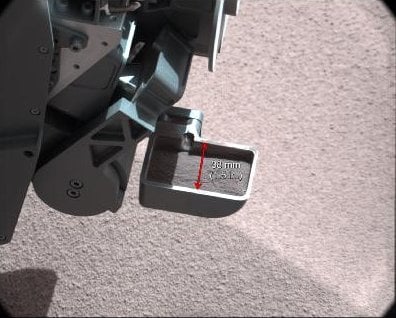
So it was then time for Curiosity to start digging around in the soil, dropping Martian dust through its chemistry and mineralogy instrument CheMin and SAM, its chemical analyst. Unfortunately, the soil sampled so far hasn't turned out to be teeming with microbial Martians. In fact, it's also quite a lot like Earth, specifically the basaltic volcanic soil of Hawaii.
The only interesting thing found in the soil were the random bright shiny bits that boffins reckon must be part of the dirt on the Red Planet. A single bit of shiny stuff that was spotted first was reckoned to be a bit off the rover, but when smaller bits kept showing up, the team decided they must be native.
Shortly after the shiny bits were announced, NASA started hinting that it had some exciting data that it needed to check again before it told the world about it. Usually when scientists say they need to check something again, they're about to announce something momentous, but unfortunately, NASA hadn't found evidence of life on Mars, instead it had found yet more evidence that its public relations are really, really terrible.
A week later, the agency got around to telling world+dog that actually, there was no news. None at all.
"Rumors and speculation that there are major new findings from the mission at this early stage are incorrect," it belatedly said, squashing all hope of any life-forms on the Red Planet for the time being.
The Goldilocks zone search
The excitement isn't all over yet though. Early this month, NASA admitted that SAM had picked up on some organic compounds in Martian soil, it just wasn't sure if they are native or not. Instead, the organics may have dropped off the rover, or could have been caused when the sample was heated for testing.
Whichever it is will have to wait until next year (or even longer) while Curiosity continues its exploration and NASA boffins keep analysing that data.
As well as searching for life on Mars, astroboffins spent the year searching for life, or a place for the human race to escape Armageddon, all over the galaxy. The quest for worlds in the habitable zone, aka the "Goldilocks zone" - where a planet could orbit its sun and potentially sustain water - was stepped up.
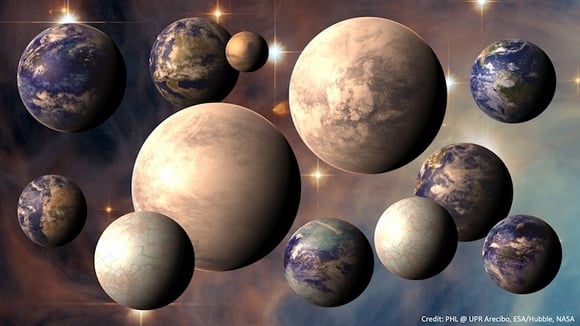
With the techniques for finding those worlds in existing and new data improving, those possible extraterrestrial homes got closer and closer to planet Earth. At the start of 2012, a six-year study said there were billions of habitable planets in the Milky Way, using the microlensing technique.
NASA's Kepler mission uses the transit method to look for dips in brightness of a star that would show a planet had passed in front of it. But PLANET, the Probing Lensing Anomalies Network, used one star as a "lens" to amplify the light from the star behind it.
The European Southern Observatory, using the HARPS spectrograph to examine 102 red dwarfs, then said that since around 40 per cent of those dwarf stars had an Earthlike rocky planet in their sweet spot, there were likely to be a hundred of them within just 30 light years of our solar system.
There are around 160 billion red dwarf stars in the Milky Way, leading the boffins to suggest that there may be tens of billions of habitable worlds in our galaxy alone.
Gas giants and super-hot planets have also been found in the right zone, although without much likelihood of life, but astroboffins are beginning to see more definite possibilities close to home.
Astronomers found a super-Earth orbiting a star only 42 light years away with a climate and atmosphere that could be just right to support life. Other scientists believe that worlds orbiting other Sunlike stars in the galaxy might actually be a tad nicer than Earth, with balmy subsurface temperatures. Seven spotted alien planets have made a new list of the confirmed worlds that could harbour life and most recently, an international team of astroboffins have found a planet in the Goldilocks zone of the nearest single Sunlike star, Tau Ceti, just 12 light years away.
Ebb, Flow and crash
This year was also the year of the GRAIL mission, which launched at the end of 2011. NASA's Gravity Recovery and Interior Laboratory craft were sent into space for a lunar study mission and met up to orbit the moon in January.
GRAIL-A, later known as Ebb, had already reached the Moon on New Year's Eve and GRAIL-B, later known as Flow, joined it a few days later. The twin flyers, named in a competition, then manoeuvered into formation flying positions to reduce their orbital period to just under two hours in order to map the rocky body's gravitational field.
The two probes, in a near-polar, near-circular orbit around the Moon, were the first attempt by NASA of such orbital precision. Engineers had to take into account the pressure effects of sunlight, both directly and bouncing off the Moon, along with heat radiation from the Moon and the crafts, minute amounts of gas escaping from the craft and the expansion and contraction of various parts of the ship in response to heating and cooling.
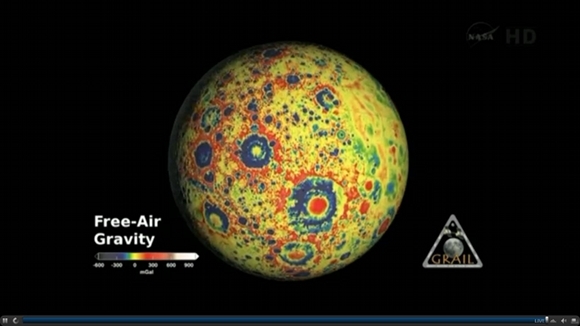
The twin GRAILs created their gravity map of the Moon by the end of the year, showing lunar boffins that the Moon is riven by deep cracks.
When large changes show up in the gravity field, boffins can piece together surface topography like craters or mountains, as well as tectonic structures, volcanic landforms, basin rings and crater central peaks. The boffins found that the Moon's crust is actually around 10km to 20km thinner than previously thought.
After their mission was complete, NASA decided on a novel way to finish with Ebb and Flow - crashing them into the Moon's surface. With the GRAILs' lifespan coming to an end, the agency got them to burn out all their remaining fuel, allowing engineers to match the actual fuel they had left to their estimates. Both craft were then flung manually at the dark side of the Moon.
NASA had the biggest mission of the year on its hands with Curiosity, but plenty of other people were making strides in space this year. If there were a non-government-affiliated Man of the Space Year award, it would undoubtedly have gone to Elon Musk, whose SpaceX firm became the first private company to supply the International Space Station.
Enter the Dragon
Despite a few delays, alright many delays, and then a failure to launch, the SpaceX Dragon finally got off the ground at the end of May.
Sitting on top of its Falcon 9 rocket, the unmanned capsule, packed with supplies and the ashes of Star Trek's Chief Engineer Scott, headed off to a rendezvous with the ISS that was due to take place a few days later.
The Dragon made an understandably cautious approach to the station, first doing a flyby within 1.5 miles (2.5km) of the ISS to ensure that 'nauts onboard were able to take remote control of the capsule. The cargoship then edged closer and stopped for some adjustments, then to within 30m of the station and stopped again, before finally reaching the 10m point where the Canadarm could grab it.
Flight Engineer Don Petit helped make history by reaching out with the robotic arm and snagging the Dragon at just before 15.00 GMT on 25 May. Whether it was down to his own rapier wit, or the combined punning abilities of NASA engineers and boffins, Petit had the perfect line for the occasion:
"Looks like we've got a dragon by the rail," he told Mission Control in Houston.
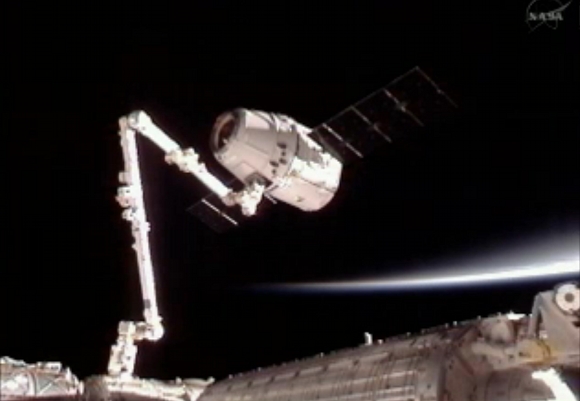
Making history once isn't enough for Musk though, he has some even more ambitious plans for the future. He hopes to be flying folks to Mars and back for around half a meeellion dollars within the next decade, with the ultimate goal of setting up a self-sustaining colony to ensure the spread of the human race. He has also said that he's thinking of building a supersonic electric jet, capable of making hovering takeoffs and landings.
But SpaceX isn't above the technical issues that all space ventures have. The second launch of a supply ship to the ISS didn't go as well as the historic first, leaving a commercial satellite stuck in the wrong orbit.
The Falcon 9 rocket suffered an engine failure as it started the climb towards space that kept the Dragon craft on track but dumped Orbcomm's sat early. Unfortunately for Orbcomm, the satellite couldn't recover and it was burnt up in the atmosphere a few days later.
Where should we park our asteroid? That Moon looks handy...
SpaceX is looking pretty good financially though. NASA, which has said that public-private partnerships are the future of space exploration, handed the firm $440m from the third development round of the Commercial Crew programme. That cash will go in the tidy pile from the NASA contract to make deliveries to the ISS, which comes in at $1.6bn.
Musk has also managed to get his foot in the door with the US military for two science projects, a deal that will offer SpaceX the chance to show its stuff and get possible further contracts of the black variety. The company announced the win of two contracts from the US Air Force, science missions in 2014 and 2015, which are likely to be testing grounds for the hugely lucrative spy-sat launch market.
Musk isn't the only former tech exec/billionaire that wants to get into space. James Cameron, a swarm of advertising tycoons and a pride of tech kingpins announced this year that they were getting into the asteroid mining biz.
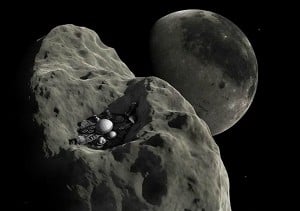
The adventurer/film-maker is teaming up with Google's Eric Schmidt and Larry Page, former Microsoftie Charles Simonyi, space tourism biz founder Eric Anderson and spacebiz visionary Peter Diamandis to send a robot ship out to the closest handy Near Earth Object (NEO) and tug it on in to orbit around the Moon.
There are some actual boffin types on board with the new firm, Planetary Resources, including former astronaut Tom Jones, former NASA JPL engineer Chris Lewicki and planetary scientist Sara Seager, who are all advisors, but the whole idea still sounds pretty madcap.
First off, the company has to find an asteroid with enough valuable metals to make the whole thing worth it, which a NASA study estimated would have to be at least 10 per cent of the space rock. And that's without the cost of the mining, refining and transportation of the ore, metals and equipment between Earth and lunar orbit.
Mining water to be used by astronauts while they're in space would seem like a much more cost-effective idea, but the technology to do that isn't around quite yet either.
Nevertheless, Planetary Resources (PR) has already engaged the services of Virgin Galactic for payload services. PR has said it will use Virgin's LauncherOne booster to blast a series of robot craft into space, including the telescopes to search out suitable NEOs.
While we can hope that this proactive hiring is a hint that PR has something amazing up its sleeve, there's always someone who will tell you that no amount of amazing is going to get this plan off the ground.
To heaven and back again
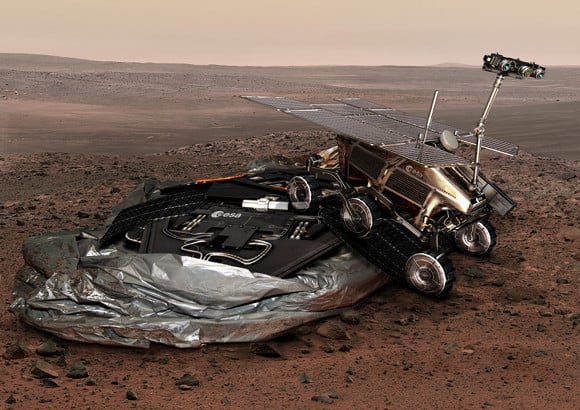
ESA's ExoMars lander and rover. Credit: ESA
All the space action this year wasn't just US-based; China and Russia were also getting on with some cosmic exploration. China led the way with its first ever manned space docking mission, which coupled with the country's Heavenly Palace space laboratory in June.
Three taikonauts floated into the Tiangong-1 lab module after the successful eight-minute docking of the craft. Two male and one female 'naut made the trip, giving China its second first, in the shape of Liu Yang, the first woman China has sent into space.
The country had already successfully docked an unmanned craft with the module, but it was the first time anyone has been onboard for the berthing. Once on Tiangong-1, the taikonauts completed a first ever manual docking, clearing the way for the extension of the Heavenly Palace into a space station, a plan China hopes to carry out in 2020.
China also has plans for Mars and the Moon, including astro-farms on both. The country is running tests in a closed cabin called the controlled ecological life support system (CELSS), which in time could be used by taikonauts on extraterrestrial bases.
Chinese space boffins want to send the country's first rover vehicle to the Moon in 2013 as well, and is considering getting its first people on the Moon after 2017, to be followed one day by a colony.
Meanwhile, Russia has stepped into the breach left by NASA in the ExoMars mission. The ESA was stuck without a partner for the Martian missions to send a satellite to look for methane and other trace gases in the atmosphere and then to send Europe's own rover, after NASA dropped out. But Roscosmos has offered its own Proton rockets to blast the missions to the Red Planet.
Apocalypse now, again
As the year drew to a close, boffins had their hands full trying to persuade people that the apocalypse wouldn't be happening on 21 December as scheduled. Five NASA scientists had to release an announcement reassuring the world that a rogue planet called Nibiru would not smash into the Earth killing us all.
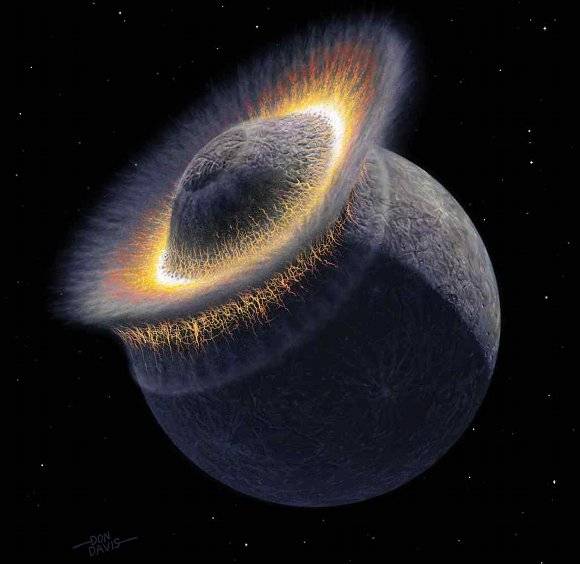
It makes no sense, because if it was there we could see it. We'd have been tracking it for a decade or so. And by now, it would be the brightest object in the sky after the Sun and Moon. You can dispel this rumour yourself, just go out and look at the sky.
They also needed to let the world's credulous know there was no way that the Earth could be plunged into a terrifying darkness lasting for three days.
There's nothing we know of physically that would allow the Sun to switch off for three days and then switch back on.
It's not the first time NASA has tried to deflect fears about the Mayan prophecy of December 2012, which some scholars have suggested refers to something a little less final like a small outbreak of disease or drought. If you're reading this now, the scholars and boffins must have been right, or it could be that the apocalypse is just running a little late... ®